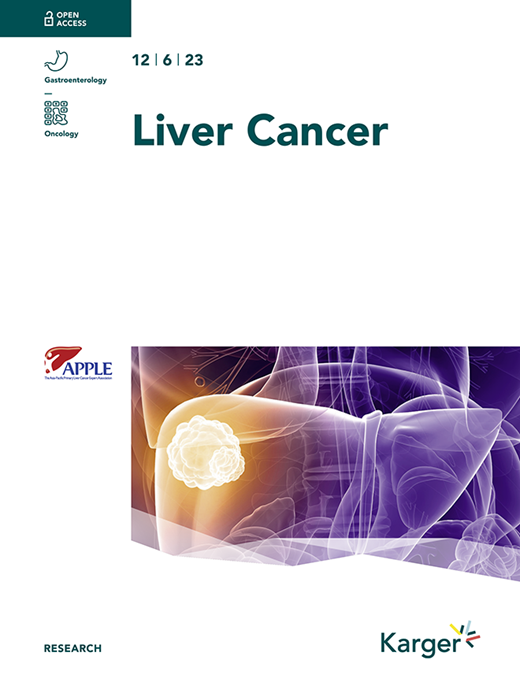Wnt/β-连环蛋白突变的人肝癌免疫微环境的两个不同特征
IF 9.1
1区 医学
Q1 GASTROENTEROLOGY & HEPATOLOGY
引用次数: 0
摘要
免疫治疗正在成为治疗不可切除的肝细胞癌(HCC)的一种有前景的方法;抗肿瘤反应受肿瘤微环境(tumor microenvironment, TME)影响。尽管有报道称Wnt/β-连环蛋白突变会导致非炎症表型,但它们在TME中的作用仍存在争议。我们旨在阐明Wnt/β-catenin突变HCC免疫表型的异质性。方法本研究纳入152例切除的hcc;连环蛋白β- 1、大肠腺瘤性息肉病或AXIN1或AXIN2基因的突变被定义为Wnt/β-连环蛋白突变。通过分层聚类分析,根据与t细胞活化相关的基因表达将TME分为炎症或非炎症类。研究人员比较了不同TME类别中与细胞分化相关的分子和胆道干细胞标记物的表达谱,以研究肿瘤特征的差异是否与TME相关。结果152例hcc中有40例(26.3%)携带Wnt/β-catenin突变。其中33例为无炎症(33/40,82.5%),7例为炎症(7/40,17.5%)。非炎症组免疫染色CD3+、CD4+和CD8+细胞数量较少,AXIN2和GLUL mRNA高表达,这两种细胞分别参与典型的Wnt/β-catenin信号传导和肝细胞分化。与炎症肿瘤相比,非炎症肿瘤的肝胆道期钆-乙氧基苄基-二乙烯三胺(Gd-EOB-DTPA)增强磁共振成像(MRI)显示更高的增强。炎症型hcc免疫染色显示CD3+、CD4+和CD8+肿瘤浸润淋巴细胞数量高。这一类与抗上皮细胞粘附分子(EpCAM)和FOXM1的表达增加有关,并伴有与干扰素- γ信号、树突状细胞迁移、调节性T细胞和MDSC激活相关的基因上调,在gd - eob - dtpa增强MRI上被识别为低增强结节。结论Wnt/β-catenin突变HCC的肿瘤特征及TME存在异质性。这表明肿瘤性状和TME不仅由HNF4A的激活决定,也由FOXM1的激活决定,两者都是Wnt/β-catenin信号通路的下游转录因子。本文章由计算机程序翻译,如有差异,请以英文原文为准。
Two distinct characteristics of immune microenvironment in human hepatocellular carcinoma with Wnt/β-catenin mutations
Introduction Immunotherapy is becoming a promising approach for unresectable-hepatocellular carcinoma (HCC); the anti-tumor response is affected by the tumor microenvironment (TME). Although Wnt/β-catenin mutations are reported to cause non-inflamed phenotype, their role on TME remains controversial. We aimed to clarify the heterogeneity of immunophenotype in HCC with Wnt/β-catenin mutations. Methods This study includes 152 resected HCCs; mutations in the catenin beta-1, adenomatous polyposis coli, or AXIN1, or AXIN2 genes were defined as Wnt/β-catenin mutations. With hierarchical cluster analyses, TME were classified into inflamed or non-inflamed classes based on the gene expressions associated with T-cell activation. Expression profiles of molecules related to cell differentiation and biliary-stem cell markers were compared between the TME classes to investigate whether differences in tumor traits were associated with TME. Results Forty of 152 (26.3%) HCCs carried the Wnt/β-catenin mutations. Of these, 33 were classified as non-inflamed (33/40, 82.5%) and 7 as inflamed (7/40, 17.5%). Non-inflamed class was characterized by low number of CD3+, CD4+, and CD8+ cells on immunostaining, and high mRNA expressions of AXIN2 and GLUL, which are involved in the canonical Wnt/β-catenin signaling and hepatocyte differentiation, respectively. Non-inflamed tumors showed higher enhancement on the hepatobiliary-phase of gadolinium-ethoxybenzyl-diethylenetriamine (Gd-EOB-DTPA)-enhanced magnetic resonance imaging (MRI) compared to inflamed tumors. HCCs classified as inflamed class are revealed to have high numbers of CD3+, CD4+, and CD8+ tumor infiltrating lymphocytes on immunostaining. This class is associated with increased expression of anti-epithelial cell adhesion molecule (EpCAM) and FOXM1 accompanied by upregulation of genes related to interferon-gamma signaling, dendritic cell migration, regulatory T cells and MDSC activation and recognized as low enhancement nodule on Gd-EOB-DTPA-enhanced MRI. Conclusion Heterogeneity of tumor traits and TME was observed in HCC with Wnt/β-catenin mutation. The potential was indicated that tumor traits and TME are determined not only by the activation of the HNF4A but also by FOXM1, both of which are downstream transcription factor of the Wnt/β-catenin signaling pathway.
求助全文
通过发布文献求助,成功后即可免费获取论文全文。
去求助
来源期刊

Liver Cancer
Medicine-Oncology
CiteScore
20.80
自引率
7.20%
发文量
53
审稿时长
16 weeks
期刊介绍:
Liver Cancer is a journal that serves the international community of researchers and clinicians by providing a platform for research results related to the causes, mechanisms, and therapy of liver cancer. It focuses on molecular carcinogenesis, prevention, surveillance, diagnosis, and treatment, including molecular targeted therapy. The journal publishes clinical and translational research in the field of liver cancer in both humans and experimental models. It publishes original and review articles and has an Impact Factor of 13.8. The journal is indexed and abstracted in various platforms including PubMed, PubMed Central, Web of Science, Science Citation Index, Science Citation Index Expanded, Google Scholar, DOAJ, Chemical Abstracts Service, Scopus, Embase, Pathway Studio, and WorldCat.
 求助内容:
求助内容: 应助结果提醒方式:
应助结果提醒方式:


